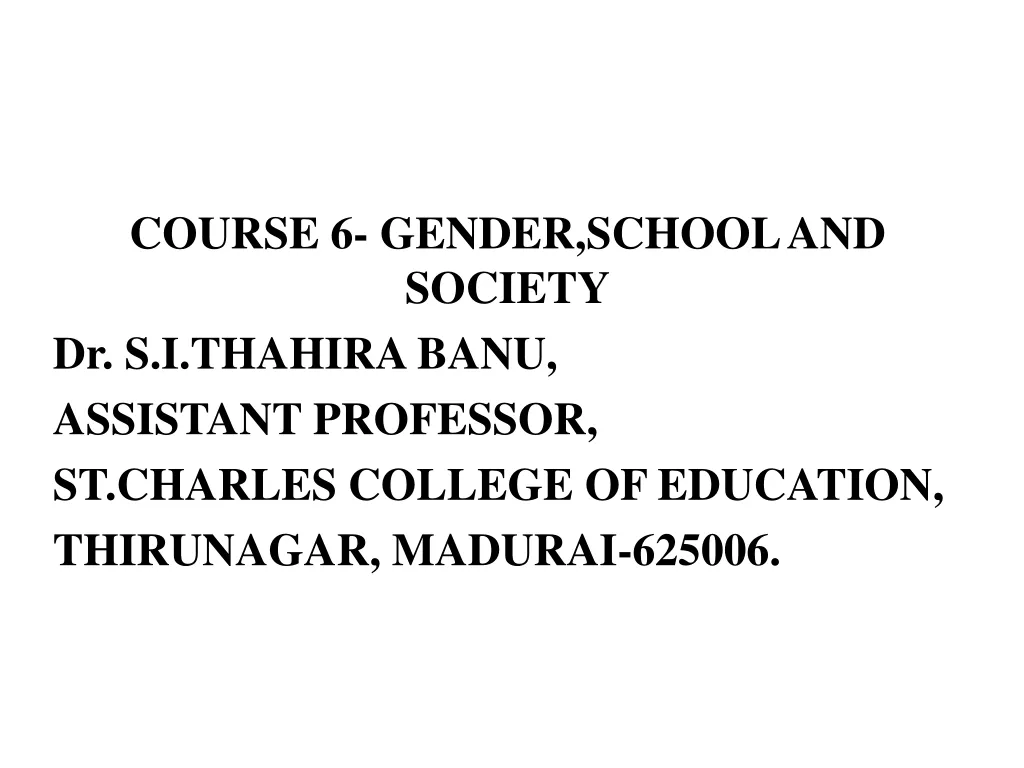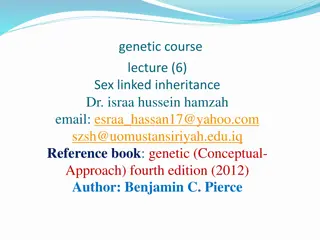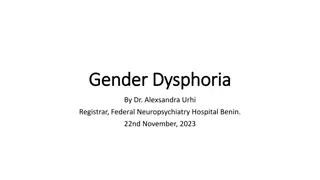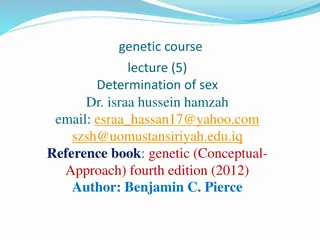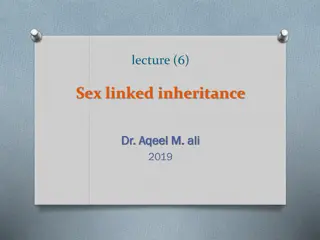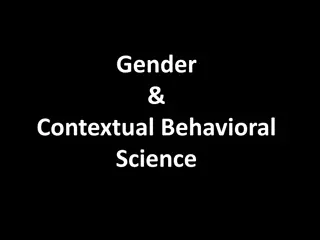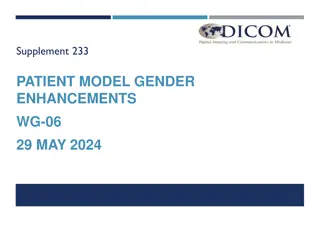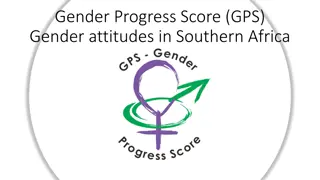Evolution of Sex and Gender Understanding
Two to three hundred years ago, the concept of sex primarily encompassed being male or female. However, over time, this has evolved to include sexual behavior and anatomy. Factors determining sex at birth involve chromosomal, gonadal, hormonal, and anatomical aspects. Chromosomal sex abnormalities such as Androgen Insensitivity Syndrome highlight variations in the sex determination process.
Download Presentation

Please find below an Image/Link to download the presentation.
The content on the website is provided AS IS for your information and personal use only. It may not be sold, licensed, or shared on other websites without obtaining consent from the author.If you encounter any issues during the download, it is possible that the publisher has removed the file from their server.
You are allowed to download the files provided on this website for personal or commercial use, subject to the condition that they are used lawfully. All files are the property of their respective owners.
The content on the website is provided AS IS for your information and personal use only. It may not be sold, licensed, or shared on other websites without obtaining consent from the author.
E N D
Presentation Transcript
Sex, Gender, and Sexual Behavior
The New Yorker June 13, 2016 It s perfect for starting a family.
Sex Two to three hundred years ago sex was simple the term sex was understood to refer to the state of being Either male or female Sex was something you belonged to or were Around 100 years ago The term sex begin to broaden Sex came to refer to sexual behavior as well as sexual anatomy Sex now became something a person could have Over the past few decades the term gender has been introduced to complicate things even more
Four Factors Determine Sex at Birth Chromosomal (genetic) sex XX (Female) - XY (Male) Fetal Gonads (reproductive organs) Ovaries (Female) - Testes (Male) Gonads begin to develop at about 7 weeks for males 9 weeks for females Hormonal balance of the fetus Estrogen and testosterone are manufactured in both female and male Balance differs from female to male Anatomical sex (sexual organs, or genitals) Genitals develop as a consequence of the hormonal balance of the fetus Development of the genitals is complete at about 16 weeks
Chromosomal (genetic) sex XY sex-determination system The DNA coding for genes is present on chromosomes People usually have 46 chromosomes in each cell Sexual development is usually determined by an individual's chromosomes the X chromosome and Y chromosome, code for sex a single gene (SRY) present on the Y chromosome acts as a signal to set the developmental pathway towards maleness. The cells in females, with two X chromosomes, undergo X-inactivation, in which one of the two X chromosomes is inactivated Swyer syndrome in Swyer syndrome, sexual development does not match the affected individual's chromosomal makeup individuals with one X chromosome and one Y chromosome in each cell, the pattern typically found in boys and men, have female reproductive structures. typical female external genitalia uterus and fallopian tubes are normally-formed, but the gonads (ovaries or testes) are not functional;
Chromosomal (genetic) sex Abnormalities Androgen insensitivity syndrome (XX males /XY females) Complete androgen insensitivity syndrome occurs when the body cannot use androgens at all Have the external sex characteristics of females, but do not have a uterus Famous example - Jamie Lee Curtis https://ghr.nlm.nih.gov/condition/androgen-insensitivity-syndrome Turner s syndrome (X) female is partly or completely missing an X chromosome http://learn.genetics.utah.edu/content/disorders/chromosomal/turner/ Klinefelter syndrome (XXY) http://learn.genetics.utah.edu/content/disorders/chromosomal/klinefelter/ XYY Syndrome (Jacob's Syndrome / XYY karyotype / YY Syndrome) Males with extra copy of the Y chromosome (47 rather than 46) http://rarediseases.org/rare-diseases/xyy-syndrome/ http://www.healthline.com/health/xyy-syndrome#Symptoms4
Fetal Gonads (reproductive organs) The first appearance of the gonad is essentially the same in the two sexes differences begin to unfold during fetal development, when the Y- chromosomal Sry ( sex-determining region Y ) gene is activated in males In the absence of the SRY gene, the gonad will differentiate into an ovary At the same time, regression of what would have become the male reproductive organs occurs Besides the SRY gene, certain hormones can influence the development of the sexual organs. These hormones are secreted during the early weeks of gestation and include the anti-M llerian hormone, testosterone hormone, and dihydrotestosterone, an active derivative of testosterone
Fetal Gonads (reproductive organs) Disorders of Sex Development https://www.urmc.rochester.edu/encyclopedia/content.aspx?Co ntentTypeID=90&ContentID=P03079 When a child's gender is in question at birth, because the genitals may not appear clearly male or female, the child is said to have atypical genitalia, also known as ambiguous genitalia When a child's genitalia appear ambiguous at birth, your child's doctor will conduct both a medical history and a physical exam of your child's external genitalia Based on a number of factors (including parental opinion and preference) A decision is made to raise the child as male or female
Hormonal balance of the fetus Hormones such as estrogen and testosterone are manufactured in both males and females The balance differs from male to female In the male fetus the production of testosterone and MIS (Mullerian inhibiting substance) Leads to the Development of male genitals and Suppression of female genital development The human embryo is essentially poised to become female and will only become male in the presence of testosterone and MIS
Anotomical Sex Sexual Organs Genitals develop as a consequence of hormonal balance Sexual organs (penis, vagina) are different from Reproductive organs (ovaries, testes) Development of genitals is completed approximately 16 weeks after fertilization
Four factors summary In the vast majority of cases these four factors Chromosones Fetal gonads Hormonal balance Anatomy Coincide to produce infants who are unambiguously male or female However, there are unusual exceptions know as Intersex
Intersex Refers to a condition where A male (XY) is born with the appearance of female genitals A female (XX) is born with the appearance of male genitals OR An infant is born with aspects of both male and female gonads and genital tissue Gonadal intersexuality (known as hermaphroditism in the past) Important because Demonstrates the two-sex system is not inevitable Sets the stage for the discussion of transgender
Gender - less easy to define than Sex Gender Identity (1950 s) Our subjective perception of the sex to which we belong or with which we identify Gender (late1970 s) Greatly broadened to promote the idea that what were then termed Sex roles (beliefs about appropriate male and female behavior) and sex differences were in fact social and psychological categories not part of human biology and therefore not inevitable Current view Separating sex and gender may cause more confusion than it cures In sum - All human behavior has biological, psychological and social cause and contexts
Gender Identity Begins in early childhood Person s subjective sense of the sex to which they belong Fundamental dimension along which human beings organize the world At about 17-19 months boys and girls begin to understand the idea of gender as expressed in labels (( lady man ) Between 24 and 30 months most children show fairly consistent awareness of their own sex or gender A gender-schema is a cognitive model about gender (Unique for every individual) Once acquired this schema controls the way the toddler attends to, responds to, and recalls information about gender
Gender identity is not limited to male and female Transsexual describes a person who identifies with the sex other than the one to which he or she was assigned at birth Some receive sex reassignment surgery Transgender can refers to any and all situations where a person is unhappy with the gender to which he or she was assigned at birth Includes transsexuals Includes any type of gender-bending Transgender means different things to different people
Gender roles Gender roles are beliefs about how men an women ought to behave Gender roles are acquired in childhood and refine over time Gender roles are not identical across the planet Gender roles vary across time Gender roles are remarkably similar across cultures and historical eras Gender stereotypes are beliefs about what men and women are like
Some videos on Gender Identification and Stereotyping Gender Roles-Interviews with Kids https://www.youtube.com/watch?v=-VqsbvG40Ww&spfreload=10 A Different Perspective on Gender Roles Within the Media https://www.youtube.com/watch?v=9d6Q72Gq850&spfreload=10 Female Stereotypes in Disney Films https://www.youtube.com/watch?v=-57zKcmrT6M&spfreload=10 Effects of Disney's Gender Stereotyping https://www.youtube.com/watch?v=Rcwkedn31hs&spfreload=10 Every Sex & Gender Term Explained (Dnews Plus) -https://www.youtube.com/watch?v=V9QnnQN880o&spfreload=10


